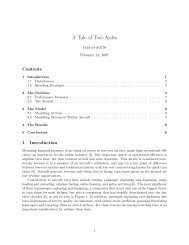Neural Models of Bayesian Belief Propagation Rajesh ... - Washington
Neural Models of Bayesian Belief Propagation Rajesh ... - Washington
Neural Models of Bayesian Belief Propagation Rajesh ... - Washington
You also want an ePaper? Increase the reach of your titles
YUMPU automatically turns print PDFs into web optimized ePapers that Google loves.
252 11 <strong>Neural</strong> <strong>Models</strong> <strong>of</strong> <strong>Bayesian</strong> <strong>Belief</strong> <strong>Propagation</strong> <strong>Rajesh</strong> P. N. Rao<br />
in uncertainty at locations closer to the focus <strong>of</strong> attention compared to locations<br />
farther away. For comparison, the responses from a V4 neuron are shown in<br />
figure 11.11C (from [4]).<br />
11.5 Discussion<br />
This chapter described models for neurally implementing the belief propagation<br />
algorithm for <strong>Bayesian</strong> inference in arbitrary graphical models. Linear and<br />
nonlinear models based on firing rate dynamics, as well as a model based on<br />
noisy spiking neurons, were presented. We illustrated the suggested approach<br />
in two domains: (1) inference over time using an HMM and its application to<br />
visual motion detection and decision-making, and (2) inference in a hierarchical<br />
graphical model and its application to understanding attentional effects in<br />
the primate visual cortex.<br />
The approach suggests an interpretation <strong>of</strong> cortical neurons as computing<br />
the posterior probability <strong>of</strong> their preferred state, given current and past inputs.<br />
In particular, the spiking probability (or instantaneous firing rate) <strong>of</strong> a<br />
neuron can be shown to be directly proportional to the posterior probability<br />
<strong>of</strong> the preferred state. The model also ascribes a functional role to local recurrent<br />
connections (lateral/horizontal connections) in the neocortex: connections<br />
from excitatory neurons are assumed to encode transition probabilities<br />
between states from one time step to the next, while inhibitory connections are<br />
used for probability normalization (see equation (11.23)). Similarly, feedback<br />
connections from higher to lower areas are assumed to convey prior probabilities<br />
reflecting prior knowledge or task constraints, as used in the attention<br />
model in section 11.4.3.<br />
11.5.1 Related <strong>Models</strong><br />
A number <strong>of</strong> models have been proposed for probabilistic computation in<br />
networks <strong>of</strong> neuron-like elements. These range from early models based on<br />
statistical mechanics (such as the Boltzmann machine [19, 20]) to more recent<br />
models that explicitly rely on probabilistic generative or causal models<br />
[6, 10, 29, 33, 43, 44, 45]. We review in more detail some <strong>of</strong> the models that are<br />
closely related to the approach presented in this chapter.<br />
<strong>Models</strong> based on Log-Likelihood Ratios<br />
Gold and Shadlen [12] have proposed a model for neurons in area LIP that<br />
interprets their responses as representing the log-likelihood ratio between<br />
two alternatives. Their model is inspired by neurophysiological results from<br />
Shadlen’s group and others showing that the responses <strong>of</strong> neurons in area LIP<br />
exhibit a behavior similar to a random walk to a fixed threshold. The neuron’s<br />
response increases given evidence in favor <strong>of</strong> the neuron’s preferred hypothesis<br />
and decreases when given evidence against that hypothesis, resulting in
















